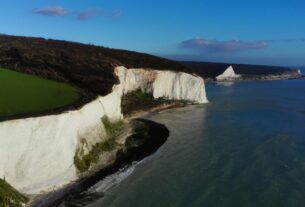Sand is an ordinary yet extraordinary natural resource that we encounter in our daily lives. From beaches to deserts, sand is a prominent sight. While its golden-yellow hue is commonly known, few are aware that sand can also be red. Have you ever wondered why sand is red? In this article, we will explore the geology and cultural significance behind this mesmerizing natural phenomenon.
Sand plays a vital role in various aspects of our lives. It is used in construction, glassmaking, and even electronics production. However, the color of sand can vary depending on its geographical location and mineral composition. While sand is typically yellow, it can also be black, white, green, and yes, even red. Red sand, in particular, is a rare and striking color that has captured the curiosity of people for centuries.
The Geology of Sand
Sand is a granular material composed of rock fragments, minerals, and shells. It forms through geological processes such as weathering, erosion, and sedimentation. As rocks and minerals break down over time, they give rise to sand with different colors and properties.
Understanding Sand
Sand is defined as granular material ranging in size from 0.063 to 2 millimeters in diameter. Its convenient transportability and malleability make it useful in construction and landscaping.
Sand Formation
Weathering, erosion, and sedimentation are the primary processes that contribute to the formation of sand. Rocks and minerals undergo weathering, breaking them down into smaller particles due to exposure to environmental factors like wind, water, and temperature fluctuations. Erosion then transports these particles through wind, water, or ice. Finally, sedimentation occurs when the particles settle and accumulate in specific locations.
Varieties of Sand
Sand comes in various types based on its mineral composition and grain size. For instance:
- Quartz sand: Composed of pure quartz grains, it is commonly found on beaches and in desert environments.
- Feldspar sand: Composed of feldspar minerals, it is often found in riverbeds and lakeshores.
- Volcanic sand: Formed from volcanic rocks, it typically exhibits a black color.
- Coral sand: Composed of coral fragments, it is prevalent in tropical regions.
The Color Palette of Sand
The color of sand is determined by its mineral composition and geographical location. While yellow is the standard association with sand, it can also be black, white, green, and, of course, red. The presence of iron-rich minerals, such as hematite or magnetite, typically gives red sand its distinctive color.
Regions of Red Sand
Red sand is a natural phenomenon found in various parts of the world, and its unique color is attributed to specific factors.
Geographic Locations
The deserts of the world are well-known for their red sand, making them popular tourist attractions. One example is the red sand dunes in Sossusvlei, Namibia. Iron oxide, present in high concentrations, imparts the reddish hue to the sand. Red sand can also be found in coastal regions, such as the red sand beaches in Prince Edward Island, Canada.
Climate and Weather Conditions
Climate and weather conditions play a significant role in the formation of red sand. High temperatures, low humidity, and sparse vegetation in desert regions create the ideal environment for red sand dunes. Coastal regions experience constant erosion and weathering of cliffs and rocks, contributing to the formation of red sand beaches.
Mineral Composition
The mineral composition of red sand varies depending on its geographical location. However, iron oxide, also known as rust, is the most common mineral responsible for the red color. Hematite and magnetite, which are abundant in desert regions, are commonly present.
Natural and Human Factors
The color of sand can be influenced by natural and human factors. Erosion, weathering, and volcanic activity are natural contributors to red sand formation. On the other hand, human-induced factors like pollution and industrialization can introduce new minerals and chemicals, affecting sand color.
In conclusion, red sand is a captivating natural phenomenon found in different parts of the world. The interplay of geography, climate, minerals, and natural and human factors contribute to the formation and color of red sand.
Red Sand in Culture and History
Red sand has captivated artists and cultures throughout history, serving as a source of inspiration and symbolism.
Symbolic and Artistic Representations
In various cultural contexts, red sand has been used as a symbol. In ancient Greek mythology, it was believed to be the blood of the god Adonis, while Hindu mythology associated red sand with the remains of a slain demon. Artists such as Wolfgang Laib and Olafur Eliasson have incorporated red sand in their installations, exploring the connection between art and nature.
Historical Uses
Red sand has been employed for a multitude of purposes throughout history. Ancient Egyptians used it in pottery and glassmaking. Different cultures utilized red sand as a pigment for dyeing fabrics and painting. Traditional medicine practices associated red sand with healing properties.
Cultural Significance
Red sand holds cultural significance in various societies. It symbolizes love and passion in some cultures, while others view it as a sign of danger or warning. Red sand is integral to cultural traditions, from sand mandalas in Tibetan Buddhism to Native American healing rituals.
In conclusion, red sand has left an indelible mark on art, history, and culture. Its vibrant color and unique qualities have made it highly valued by artists and cultures across time. By delving into the symbolic, historical, and cultural aspects of red sand, we gain a deeper appreciation for this captivating natural phenomenon.
Other Colors of Sand
While red sand is undoubtedly fascinating, it is just one of the myriad colors that sand can exhibit.
The Spectrum of Sand Colors
Sand can display a range of hues, including black, white, green, and even purple. Black sand typically originates from volcanic minerals like basalt, while white sand comprises predominantly quartz. Green sand is often found in areas abundant in olivine, which imparts the green color. Purple sand, a rarity, owes its hue to the presence of manganese.
Comparing Red Sand
Each color of sand possesses distinctive properties. Black sand suggests volcanic activity, while white sand is frequently associated with tropical areas featuring coral reefs. Green sand thrives in regions with high olivine levels or near beaches with olivine deposits. Purple sand, though infrequently encountered, has been found along California’s Big Sur coastline.
Mineral Composition and Geographic Distribution
Regardless of color, sand consists of small rock or mineral fragments. The mineral composition of sand depends on its geographical location, with some areas having a higher concentration of specific minerals. For instance, red sand often contains iron-rich minerals, while black sand typically contains volcanic minerals.
In terms of distribution, red sand is commonly found in iron-rich areas like Australia, whereas black sand predominates in regions with active volcanoes such as Hawaii. White sand is prevalent in tropical locations like the Caribbean, while green sand thrives in areas abundant in olivine, such as Hawaii. Meanwhile, purple sand is a rarity found in limited quantities, although it has been discovered along California’s Big Sur coastline.
In conclusion, while red sand is undoubtedly captivating, it is just one hue in the kaleidoscope of sand colors across the globe. Each shade possesses its unique features, shaped by mineral composition and geographical factors. Understanding the diverse palette of sand enriches our appreciation for this ubiquitous natural resource.
Conclusion
Sand is an omnipresent natural resource that plays a significant role in our lives. Its color, influenced by geographical location, mineral composition, and climate, can vary from the familiar golden-yellow to enchanting red, among other hues. Through exploring the geology and cultural significance of red sand, we unravel the mysteries surrounding this captivating natural phenomenon.
At TooLacks, we are dedicated to providing informative and engaging content about nature, gardening, animals, and more. We hope you found this article enlightening and enjoyable. Thank you for reading, and for more exciting content, visit TooLacks.


